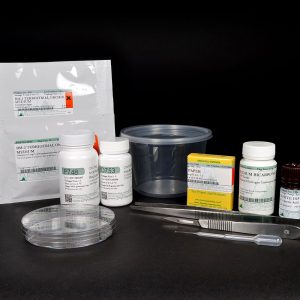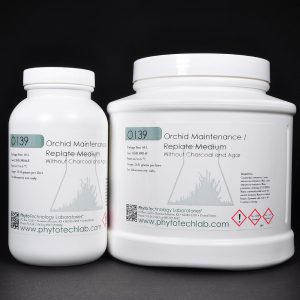
PPM – PLANT PRESERVATIVE MIXTURE
PPM™ – 30ml, 100ml, 250ml, 500ml & 1000ml.
PPM™ is the ultimate solution to the never-ending struggle against microbial airborne, waterborne and endogenous contamination.
Description
Info: Plant culture preservative and biocide
Product Number: PPM
Storage Conditions: 39ºF / 4º C
PRODUCT DESCRIPTION
Plant Preservation Mixture (PPMTM) is a robust broad-spectrum biocide formulated for use in plant tissue culture. PPMTM targets bacteria and fungi in plant tissue culture growth media as well as contaminated tissue. It affects key enzymes in the Krebs cycle and in the Electron Transport Chain. Depending on the dose and the level of contamination, PPM is a biocidal component in plant culture medium. In addition, it may also function as a bio-static compound as a preventative measure. When
diluted with plant growth media it is effective as a micro-biocide (i.e. bactericide and fungicide) against non-human health pathogenic organisms component of liquid or
semi-solid plant culture media.
PPMTM is effective for most seed baring plants – angiosperm, as well as gymnosperm,- however, it is not recommended for use in ferns, mosses, algae and aquatic plants. Optimization may be required to maximize potency. While PPM is an excellent tool in the prevention and elimination of culture contamination it is not a substitute for
aseptic laboratory techniques and appropriate air handling systems are recommended.
Composition Proprietary
PHYSICAL PROPERTIES
Physical form: Solution
Appearance: Clear, colorless to amber
pH: 3.8
STABILITY
Store vial at 4 C.
See label for expiration date
PPM may be added to media prior to sterilization or directly to sterile media prior to dispensation.
Auto-clavable at 1.05 kg/cm2 (15 psi) and 121°C for 20 minutes.
PPM should be added post-autoclave to media containing proteins, prior to dispensing to culture vessels.
PPM at final concentration (diluted in medium) is stable at ambient temperatures for up to 1 month.
PRECAUTIONS
It is a violation of Federal Law to use this product in a manner inconsistent with its labeling. See MSDS for safety, handling, and disposal instructions.
USAGE
The instructions listed below are for general use. Optimization may be required.
| PPM Quick Reference | Maintenance | Sterilization | Agrobacterium |
| Concentration (v/v) | 0.05 – 0.2% | 5.0% (see note) | 0.05 |
| Duration | Continuous | 4 – 12 hours | Continuous |
| Note |
Plant tissue types vary, optimization is required. For freshly isolated protoplast or callus use 0.05% Higher concentrations may result in toxicity or uptake. |
In 3X MS salts (use dry powder formulation from commercial companies) Do not use in combination with other sterilization techniques. Do not adjust pH. Treated tissues should be placed directly into culture medium of choice containing 0.05% PPM. |
May be added to antibiotic cocktail.
|
PATENT NO. 5,750,402 – The formulation of PPM in tissue culture media at certain concentrations and the use of PPM in tissue culture at certain concentrations to prevent
or eliminate microbial contamination is protected by US patent No. 5,750,402. Patents have been issued in Canada, New Zealand, Australia, the European Community, Israel and other countries. It is also patent pending in many other countries of the world.
REFERENCES
Miyazaki J, Tan BH, Errington SG. Eradication of endophytic bacteria via treatment for axillary buds of Petunia hybrida using Plant Preservative Mixture (PPMTM). PCTOC. 2010;102(3):365-372.
Miyazaki J, Tan BH, Errington SG, Kuo JS. Bacterial endophyte in Macropidia fuliginosa: its localisation and eradication from in vitro cultured basal-stem callus. Aust J Bot. 2011;59(4):363-368.
Lata H, Chandra S, Khan IA, ElSohly MA. Propagation through alginate encapsulation of axillary buds of Cannabis sativa L. — an important medicinal plant. Phys and Mol Biol of Plants. 2009;15(1):79-86.
Greer SP, Rinehart TA. Dormancy and Germination In Vitro Response of Hydrangea macrophylla and Hydrangea paniculata Seed to Light, Cold-Treatment and Gibberellic Acid. J. Environ. Hort. 2010;28(1):41–47.
Moghaddam S, et al. Optimization of an Efficient Semi-Solid Culture Protocol for Sterilization and Plant Regeneration of Centella asiatica (L.) as a Medicinal Herb. Molecules. 2011;16(11): 8981-8991
Çolgecen H, Koca U, Toker G. Infl uence of diff erent sterilization methods on callus initiation and production of pigmented callus in Arnebia densifl ora Ledeb. Turk J Biol. 2011; 35:513-520
Pouvreau J, et al. A high-throughput seed germination assay for root parasitic plants. Plant Methods 2013;9:32
Marecik R, Bialas W, Cyplik P, Lawniczak L, Chrzanowski L. Phytoremediation Potential of Three Wetland Plant Species Toward Atrazine in Environmentally Relevant Concentrations. Pol. J. Environ. Stud. 2012;21(3):697-702
Pérez Flores J, Aguilar Vega ME, Roca Tripepi R. Assays for the in vitro establishment of Swietenia macrophylla and Cedrela odorata. Rev. Colomb. Biotecnol. 2012;14(1)
Nesterenko-Malkovskaya A, Kirzhner F, Zimmels Y, Armon R. Eichhornia crassipes capability to remove naphthalene from wastewater in the absence of bacteria. Chemosphere. 2012;87(10):1186-1191.
Kieffer M, Fuller MP. In Vitro Propagation of Cauliflower Using Curd Microexplants. Meth Mol Biol. 2013;994:329-339.
Kodym A, Temsch E, Bunn E, Delpratt J. Ploidy stability of somatic embryo-derived plants in two ecological keystone sedge species (Lepidosperma laterale and L. concavum, Cyperaceae). Aust J Bot. 2012;60(5):396-404.
Peña-Ramírez YJ, et al. Induction of somatic embryogenesis and plant regeneration in the tropical timber tree Spanish red cedar [Cedrela odorata L. (Meliaceae)]. PCTOC. 2011;105(2):203-209.
Haddadi F, Adb Aziz M, Saleh G. Abd Rashid A, Kamaladini H. Micropropagation of Strawberry cv. Camarosa: Prolific Shoot Regeneration from In Vitro Shoot Tips Using Thidiazuron with N6-benzylamino-purine. HortScience. 2010;45(3):453-456.
Jimenez VM, Castillo J, Tavares E, Guevara E, Montiel M. In vitro propagation of the neotropical giant bamboo, Guadua angustifolia Kunth, through axillary shoot proliferation. PCTOC. 2006;86:389–395.
Compton ME, Koch JM. Influence of Plant Preservative Mixture (PPM) on adventitous organogenesis in Melon, Petunia, and Tobacco. In Vitro Cell. Dev. Biol.- Plant. 2001;37:259-261
Additional information
| Sizes | 30 ml, 100 ml, 250 ml, 500 ml, 1000 ml |
|---|

 Français
Français 





Reviews
There are no reviews yet.